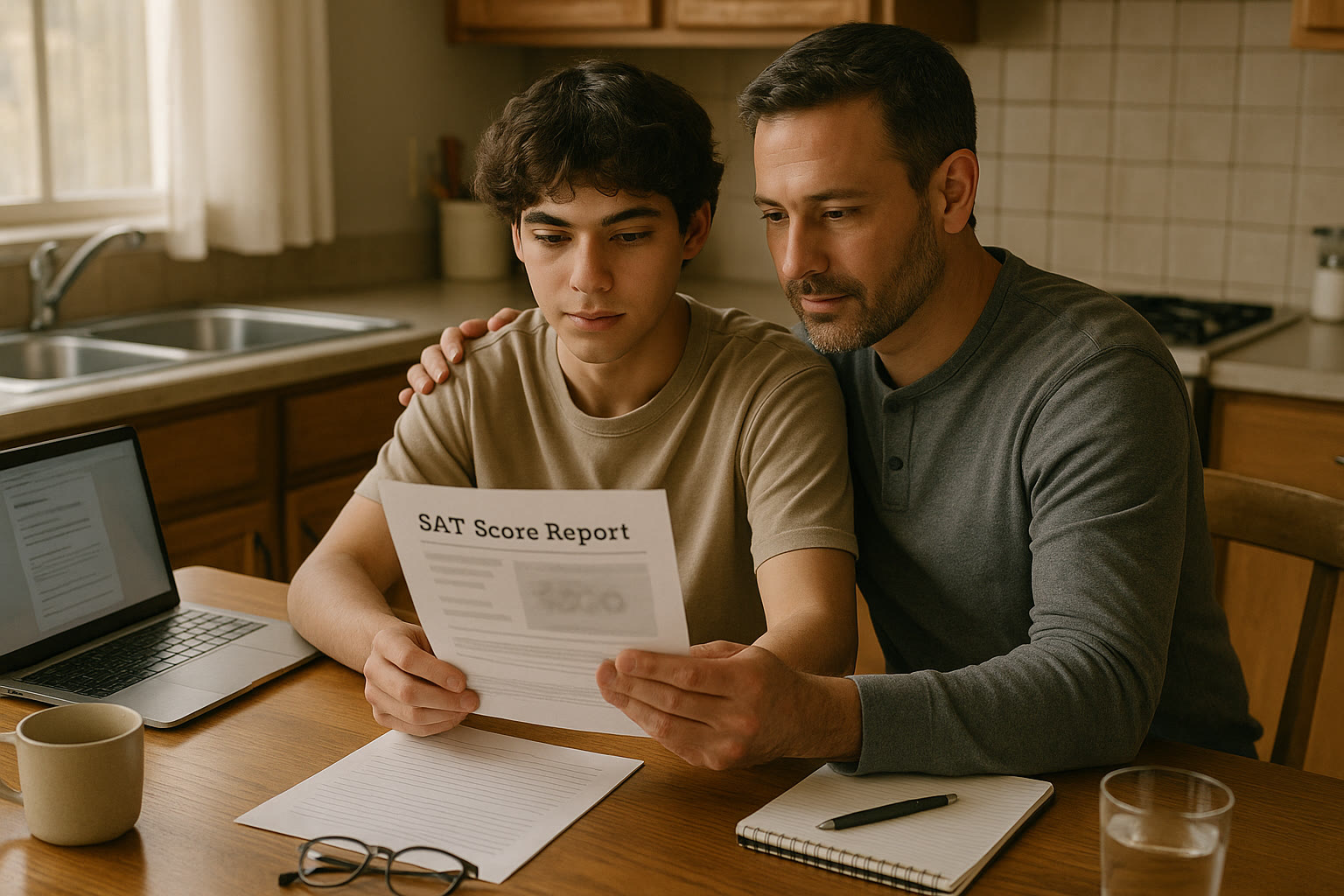So you opened your SAT score report—now what?
First: breathe. Whether you smiled, sighed, or felt a little queasy when you saw the number, your SAT score is one piece of a larger story—your academic record, your extracurriculars, your essays, recommendations, and the unique ways you’ll show up on campus. This guide walks you and your family through clear, practical steps to make smart decisions after you receive digital SAT scores, with real-world context, examples, and a few tips about when to bring in personalized help like Sparkl’s tutoring.

1. Understand your score report — take five minutes to read it properly
Score reports can look dense, but they contain a few key pieces of information you’ll want to understand before reacting:
- Your total score and section scores (Evidence-Based Reading and Writing and Math, in the older scale this was combined; with the digital SAT, review how your score components are presented on your report).
- Percentile — how your score compares to other test takers. This helps set realistic expectations for selectivity.
- Section-level strengths and weaknesses — topic or question-type feedback that points to what to review.
- Testing history — if you’ve taken the SAT before, compare your progress over time.
Example: if your math section shows solid algebra but weaker data interpretation skills, your study time should tilt toward charts, tables, and problem sets that mimic that format. If reading shows vocabulary and inference gaps, prioritize active reading and practice passage-based questions.
2. Put your score in context
Compare to your college list and targets
Pull up the score ranges (or typical ranges) for the colleges you care about. A single number has different meaning depending on the school—what’s competitive at one campus could be below or above the typical range at another. Match your score to where you are on your list and ask: does this number keep my current choices realistic?
Look at your whole application
Admissions officers evaluate your transcript, classes taken, GPA, essays, recommendations, extracurriculars, and demonstrated interest alongside test scores. For students with strong coursework (rigorous classes, upward trends), a modest SAT score may be less consequential. Conversely, if your GPA is lower, a stronger SAT might help reinforce academic readiness.
Talk to your counselor
Your high school counselor can offer insight into how similar students from your school have fared with comparable scores. They can also advise about test-optional policies, institutional norms, and internal deadlines.
3. Decide whether to keep, cancel, or send scores
Keep, cancel, or send?
- Keep: If your score meets or exceeds your target schools’ ranges and reflects your potential, you can simply focus on next steps: sending scores and moving forward with applications.
- Cancel/Withhold (if available): If your test was recent and you’re certain you’ll retake quickly, some systems let you withhold scores—tread carefully; see deadlines and policies before deciding.
- Send to colleges selectively: Some colleges require all scores; others allow score choice. Check each school’s policy and choose the option that best represents you.
Tip: even if you think a score is low, you may still want to send it if your application has other compelling strengths. Conversely, if you plan to retake, review whether sending now could limit your options later based on a school’s score policies.
4. If you’re unsure about retaking, follow this decision checklist
Use these questions to make a calm, rational choice about a retake:
- Does my score meet the median or typical range at my target schools?
- Do I have time before application deadlines to study and retake?
- Can targeted preparation realistically add the points I need (for example, focusing on one weaker section)?
- Do I have resources and support—practice materials, a study plan, or tutoring—to improve efficiently?
If you answered yes to those, plan a focused retake strategy. If no, focus energy on essays, recommendations, and extracurriculars where you can make a stronger impact.
5. Build a smart study plan if you retake
Targeted, time-boxed practice beats aimless prep
Instead of vague studying, create a 6–8 week plan that zeroes in on weak areas revealed by your score report. A sample plan could look like this:
| Week | Main Focus | Practice Activities | Goal |
|---|---|---|---|
| 1–2 | Diagnostic & fundamentals | Full-length digital practice test, concepts review, drills | Identify top 3 weak topics |
| 3–4 | Weak topics practice | Timed sections, targeted problem sets, error log | Improve accuracy and pacing |
| 5–6 | Timing & endurance | Full timed digital tests, review, test-day routines | Consistent scoring and stamina |
| 7–8 | Polish and strategy | Practice under simulated conditions, final review | Optimize strategy and confidence |
Keep an error log: record question type, mistake reason, and a short correction. That log is the single most powerful tool to prevent repeating errors.
When to consider personalized help
If your score report shows concentrated weaknesses or you’ve hit a plateau despite study, personalized tutoring can compress months of progress into weeks. Sparkl’s personalized tutoring offers 1-on-1 guidance, tailored study plans, expert tutors, and AI-driven insights that analyze your performance and recommend the most effective next steps. The right tutor helps you turn weak question-types into reliable points.
6. Use score feedback to improve other parts of your application
Even if you don’t retake, your score report gives useful signals you can use elsewhere:
- Essay focus: If reading or evidence-based writing is weaker, your personal statement and supplementary essays are places to show clear, structured thinking and strong communication. Drafts that mirror the structure and evidence-based reasoning tested on the SAT can help.
- Teacher recommendations: Ask teachers who can speak to your academic growth. If a score is lower than you hoped, a teacher’s note about your problem-solving growth or class contributions can add narrative context.
- Course choices: If you still have time in high school, choose senior-year courses that signal rigor and readiness for your intended major (for example, AP or dual-enrollment math for STEM-focused students).
7. Practical steps to send scores, join services, and manage privacy
Sending scores to colleges
Decide which schools should receive scores now and which you might add later. Check each institution’s documentation about score-choice versus all-scores policies and follow the method recommended by the testing authority for submitting results.
Use Student Search Service wisely
Student Search Service can connect you with colleges and scholarship programs that match your profile. Opting in can surface opportunities you haven’t considered. It’s voluntary and won’t share sensitive details like actual test scores to recruiters. For families who want broader exposure, it’s a low-effort way to let colleges find you.
Protect privacy and understand sharing options
Know how your testing agency shares information and what you can control. If you’re using a college planning mobile app or third-party tool, check what data is shared and when. Being proactive about privacy prevents surprises.
8. Financial and scholarship considerations after scores
Some merit scholarships use SAT scores as part of their selection criteria. After receiving scores, update your scholarship search by filtering for awards that consider test scores. Also, many colleges provide automatic merit packages based on submitted scores—knowing where you fall can inform conversations about affordability and early deadlines.
9. Taking the emotional and practical perspective: how parents can help
Parents, your reaction shapes your teen’s next steps. Validate feelings, then move to action. Here’s a simple approach:
- Listen first. Let your student express disappointment or relief without immediate judgments.
- Frame choices. Ask: Do we want to retake, or double down on other parts of the application?
- Support logistics. Help with registration, scheduling, and, if desired, finding extra help like Sparkl’s tutoring to build a targeted plan.
Remember: a collaborative tone—partnering on decisions rather than directing them—builds confidence and better outcomes.
10. Two real-world examples to illustrate paths forward
Example A: Maya — target schools are competitive, score slightly below median
Maya scored a bit below the median for her top-choice schools, and her score report shows specific reading-inference weaknesses. She has time before deadlines. Plan: 6-week targeted prep focusing on inference and passage structure, two full practice tests, weekly check-ins with a tutor, and a polished application highlighting AP course performance. Sparkl’s 1-on-1 tutoring helped Maya turn weak question-types into steady gains by using AI-driven practice patterns that prioritized her most frequent mistakes. Result: a retake that nudged her score into the target range and a stronger application narrative.
Example B: Jordan — score meets safety and match list but below reach schools
Jordan’s SAT aligns with safety and match schools; reach schools remain aspirational. He decides not to retake, instead investing time in essays that tell a compelling story about his leadership and a final art portfolio update. He opts into Student Search Service to get scholarship and program emails he hadn’t known about. This balanced approach keeps stress low and showcases the full breadth of his candidacy.
11. Timeline checklist: what to do in the weeks after scores
| Timeframe | Action |
|---|---|
| Immediate (0–3 days) | Read score report carefully, breathe, talk with family/counselor, decide whether to keep or send scores |
| Week 1 | Compare to college targets, check score policies, consider Student Search Service, decide on retake |
| Weeks 2–8 | If retaking: implement focused study plan, practice tests, error logs, tutoring if needed |
| Before deadlines | Send scores (if final), finalize essays, update counselor and recommenders, submit applications |
12. Test-day and registration practicalities for a retake
Before you register for another SAT administration, check dates, registration deadlines, and the digital format specifics. If you plan to retake, register early to secure a preferred testing site and avoid late fees. During prep, simulate test-day conditions with full-length digital practice tests to build pacing and endurance.
13. When to bring in professional help — and what to expect
If progress stalls or you want to accelerate improvement, consider dedicated, personalized tutoring. Look for services that offer:
- 1-on-1 guidance tailored to your precise score-report weaknesses
- Custom study plans that fit your schedule
- Expert tutors with proven strategies for the digital SAT question types
- Data-driven insights—ideally AI-backed—that track improvement and recommend practice that actually moves the needle
Sparkl’s personalized tutoring combines these elements: expert tutors who translate your score report into a weekly plan, AI-driven practice suggestions to focus on highest-impact areas, and regular progress reviews so you don’t waste effort on low-return activities. Many families find that focused guidance transforms uncertainty into measurable gains.
14. Final reflections: tests don’t define your story
Your SAT score is not the final word on who you are or what you can accomplish. It’s a snapshot—useful, but partial. Colleges read applications holistically, and your essays, recommendations, portfolio of work, and the trajectory of your academics often matter as much or more than any exam number. Treat the score as information, not a verdict.

Quick reference summary: the 7-step post-score action plan
- Understand the report: Read your scores and section feedback carefully.
- Contextualize: Compare your score to college targets and your transcript.
- Decide: Keep/send, retake, or shift focus to other application strengths.
- Plan: If retaking, create a focused 6–8 week study plan with practice tests and error logs.
- Consider help: Use personalized tutoring when you need targeted gains—look for tailored plans and data-driven feedback.
- Send & connect: Manage score sending, opt into Student Search Service if useful, and protect your privacy.
- Remember: Your whole application tells the story—let the test be one part of it.
Closing note to students and parents
Getting your SAT scores can feel like a full stop—or a comma. Treat it as the latter: a pause to gather information, make a plan, and move forward with intention. If you need focused, efficient support, consider reaching out for personalized tutoring that meets you where you are—help that translates a report into clear, measurable progress. With calm reflection and a good plan, this moment becomes momentum.
Ready for the next step?
Make the small, intentional choices that add up: review the report, set a target, and pick one or two high-impact actions—whether it’s a focused study schedule, a great essay draft, or a conversation with a counselor. If you want help building a tailored plan that’s efficient and goal-directed, a short consultation with a tutor who knows the digital SAT inside out (and who can combine 1-on-1 coaching with data-driven practice) can be the fastest route from uncertainty to confidence.
Good luck—you’ve got options, and you don’t have to navigate them alone.
















No Comments
Leave a comment Cancel